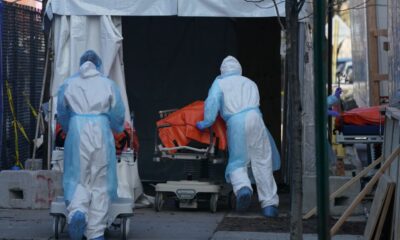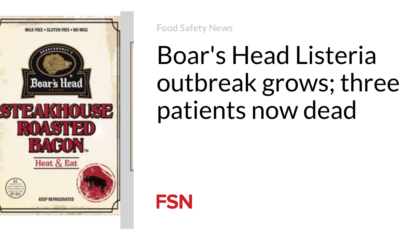Health
The differences in post-hospital care for heart patients are increasing

RRecovery from a heart-related hospitalization requires coordinated, timely care to prevent a return to the hospital for an avoidable readmission. A new study finds that while the picture for all Medicare patients is growing brighter, persistent racial disparities are widening.
Poorer and rural patients were also less likely to have prompt post-discharge visits to check things like medications, a common factor in readmission.
The study is based on Medicare claims data over a ten-year period published Monday in the Annals of Internal Medicineit was examined whether patients with a heart attack or heart failure had visited a cardiologist or a general practitioner within the critical month after discharge.
After nearly 6 million patients were hospitalized for these serious heart diseases between 2010 and 2019, post-discharge visits to a cardiologist increased from 48.3% to 61.4% of heart attack patients and from 35.2% to 48.3% of patients with heart failure. Yet more than 20% of heart attack patients and 30% of heart failure patients were not seen by a GP or cardiologist within 30 days of leaving hospital.
The largest racial and ethnic differences were between black and white patients. Regarding follow-up care for a heart attack within a month, 52% of black patients, but 60% of white patients received it; for heart failure this was 40% of black patients versus 49% of white patients.
There was also a difference between heart attack patients who were eligible for both Medicare and Medicaid, which was seen as indicative of lower income and greater social disadvantage. Of those who were dually eligible, 53% received immediate follow-up visits, compared with 60% of those who were not dually eligible after a heart attack; for heart failure this was 40% versus 49%.
Existing disparities widened for Asian, black, and Hispanic patients, as well as for patients eligible for both Medicare and Medicaid, and for people living in counties with higher levels of social deprivation.
How much wider was the gap with white patients? After a heart attack, the difference for Latin American patients grew from 2 percentage points in 2010 to 6 percentage points in 2019. After a hospital admission for heart failure, the difference for Asian patients increased from 2 to 8 percentage points; for black patients, from 7 to 9 percentage points; for Spanish-speaking patients, 5 to 8 percentage points; and between dually eligible patients and other patients, from 9 to 10 percentage points.
“It is reassuring to see that we are making progress towards improving post-hospital care in twenty years of focusing so much on post-hospital outcomes, but not looking at whether we are actually providing care to people when they leave the hospital,” Timothy Anderson, assistant professor of medicine at the University of Pittsburgh and co-author of the study, said in an interview. “The goal of our study is to understand not only what improvements have been made in post-hospital care, but also how equitable these improvements have been.”
The patients in the analysis were in Medicare’s fee-for-service program and thus not members of Medicare Advantage plans.
One of the biggest barriers to post-discharge care for many patients can be the lack of easy access to a physician, nurse practitioner, or physician assistant. Finding heart specialists is particularly difficult for patients in rural areas.
“Patients may be admitted for a heart attack, but then they’re just sent home and they may be told to report to a doctor, but they have no one to follow up with,” said Michael Thompson, an assistant. professor of cardiac surgery at Michigan Medicine, who was not involved in the new study. “Continuity of care assumes that there is continuity of care before the event, which is not always the case.”
Follow-up is important for many reasons. Doctors can monitor patients’ recovery, adjust their medications and plan other care as they transition from the hospital to home. Patients may need laboratory tests or imaging studies, plus rehabilitation to resume activities of daily living and receive advice on improving their diet and exercise habits. They also need instructions on how to watch for complications of their heart disease that require medical attention, and for some, help with the depressive symptoms that are common after a heart attack.
Previous research has linked timely follow-up to better consistency when it comes to taking medications, which in turn is associated with lower readmission rates among heart failure patients in particular, who are more vulnerable to setbacks that set them back to a hospital. Heart failure is diagnosed when the heart cannot pump blood around the body as well as it should.
“When someone leaves the hospital, that’s really the leverage to improve people’s outcomes,” Anderson said.
The researchers looked more closely at groups of patients who were already known to experience differences in their cardiovascular outcomes.
“If we improve the overall numbers, but the disparities become greater, are we really doing a good job of improving care for everyone?” said Thompson, whose research focuses on understanding the quality and value of health care, especially for patients with cardiovascular disease. “And the answer is clear: probably not.”
The analysis revealed differences within and between hospitals. Within a hospital, follow-up visits remained lower for patients who were black or Hispanic, lived in a rural area, were eligible for both Medicaid and Medicare, and whose county experienced a social disadvantage to score.
In hospitals where the proportion of patients dually eligible for Medicaid was 20% higher than in other hospitals, the likelihood of follow-up visits was 21% lower after heart attack and 25% lower after heart failure. Smaller differences were observed between hospitals for female, rural, and black patients in patient census.
The researchers suspect that a policy implemented to reduce hospital readmission rates may have had unintended consequences that were reflected in follow-up visits. A Medicare-funded initiative through the Affordable Care Act encouraged transitional care management by offering financial incentives to connect patients with outpatient physicians who would care for the first 30 days after returning home from a hospital or nursing home.
Medicare payments to safety-net hospitals—which may care for sicker, more complicated, and more disadvantaged patients—ultimately were lower than to better-equipped hospitals serving higher-income patients.
“The challenge with that program, which is also well intentioned, is that you have to have a very good infrastructure to make it work, because you have to have a nurse call the patient within two days,” Anderson said. “If you are an under-resourced safety net clinic, you may not know for a few days that your patient has been discharged from a hospital because you are not part of the health care system where the clinic and the hospital are all together. on the same page.”
The authors came up with several ideas to reduce the gaps in care. Telehealth could help connect patients and doctors faster and easier than in-person visits.
But Shivani Patel, an epidemiologist at Emory University’s Rollins School of Public Health whose research focuses on cardiometabolic health, noted the digital divide between rural and urban residents when it comes to telehealth connectivity and perhaps digital literacy. Patel was not involved in the study but called it well conducted, using a solid data infrastructure and strong methodology.
“If we have a telehealth visit instead of an in-person visit, can we reduce the risk of a future readmission?” she said. “This is a population with a very high risk of mortality. It is also a population, in terms of all cardiovascular conditions in a population that may be more socioeconomically disadvantaged, that faces multiple barriers at home when it comes to managing their care. And then it looks like we don’t see them in time.”
“Telehealth can start to close that gap, but I guess we’ll have to know later if it actually works as well as in-person health care?”
Telehealth has shown promise for one stretch after discharge: cardiac rehabilitation, a program that combines counseling with exercise to improve heart health after treatment for a heart attack or other illness. Some studies have shown that virtual or hybrid cardiac rehab is just as good as an in-person program, which ideally could help with travel or geographic barriers, Thompson said.
Another solution could come from better sharing of electronic health records between healthcare systems, so that out-of-hospital doctors would be notified of their patients’ admissions for heart attack or heart failure – if those patients had had that connection beforehand.
Prevention is central to timely aftercare – checking medications, recommending rehabilitation. Cost can be a barrier for people using Medicare, but that shouldn’t be the case, Thompson said, based on research showing that financial incentives for patients combined with case management drove many more people to rehab.
After all, Medicare is not free.
“Paying for a cardiac rehab session is much cheaper than paying for a stent,” Thompson said. “As far as I’m concerned, we shouldn’t make people pay for things that would ultimately save everyone money.”
Patel said the study’s figures could help inform future policy.
“One thing I find encouraging about these findings is that overall, the absolute change within each demographic stratum increases when we see a provider within 30 days,” she said. “When I look at this data, I see that to some extent the increasing disparities we are seeing are not a result of another group necessarily getting worse, but rather the group that is best off even further off.” is improved.”
STAT’s coverage of chronic health conditions is supported by a grant from Bloomberg Philanthropies. Us financial supporters are not involved in decisions about our journalism.













